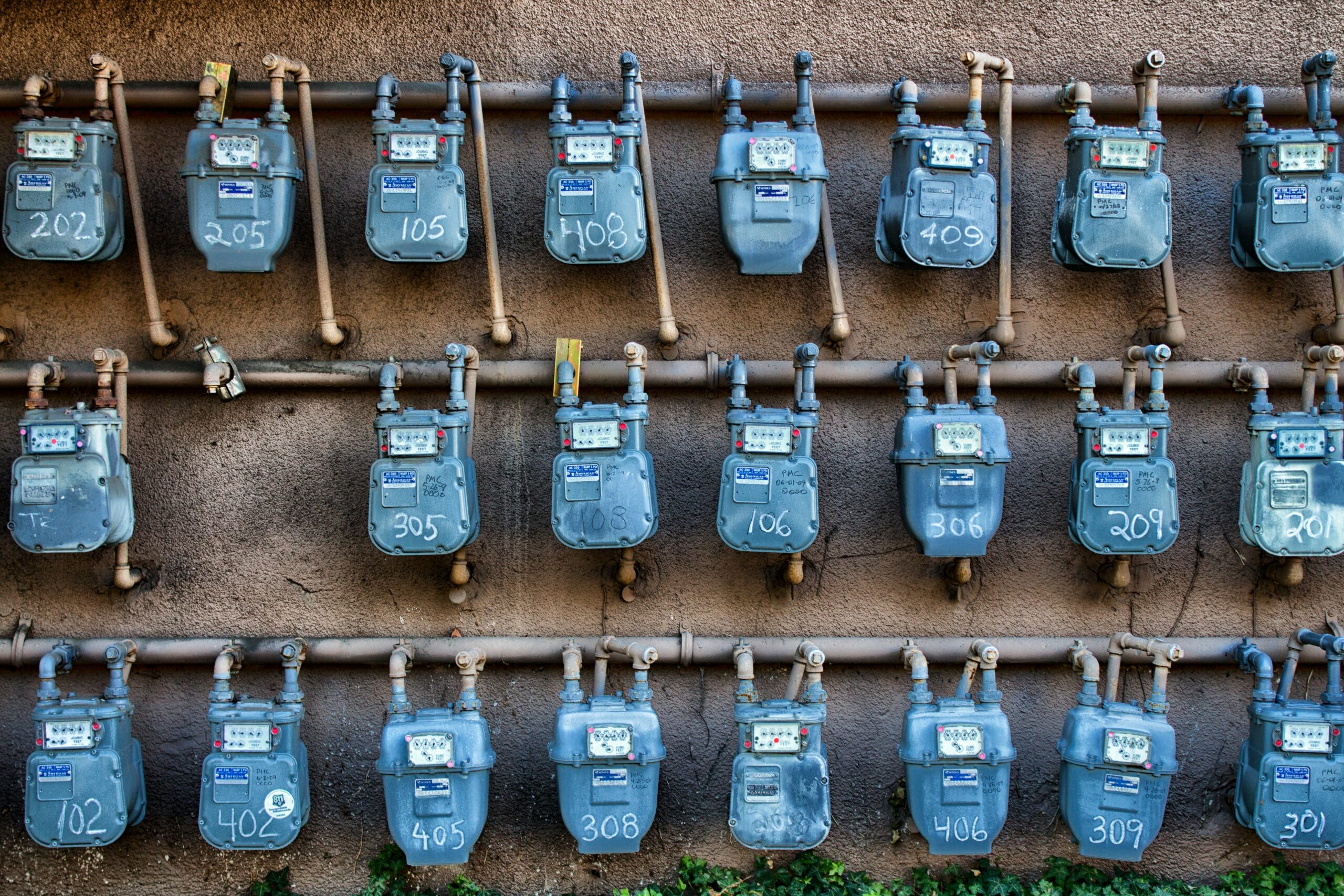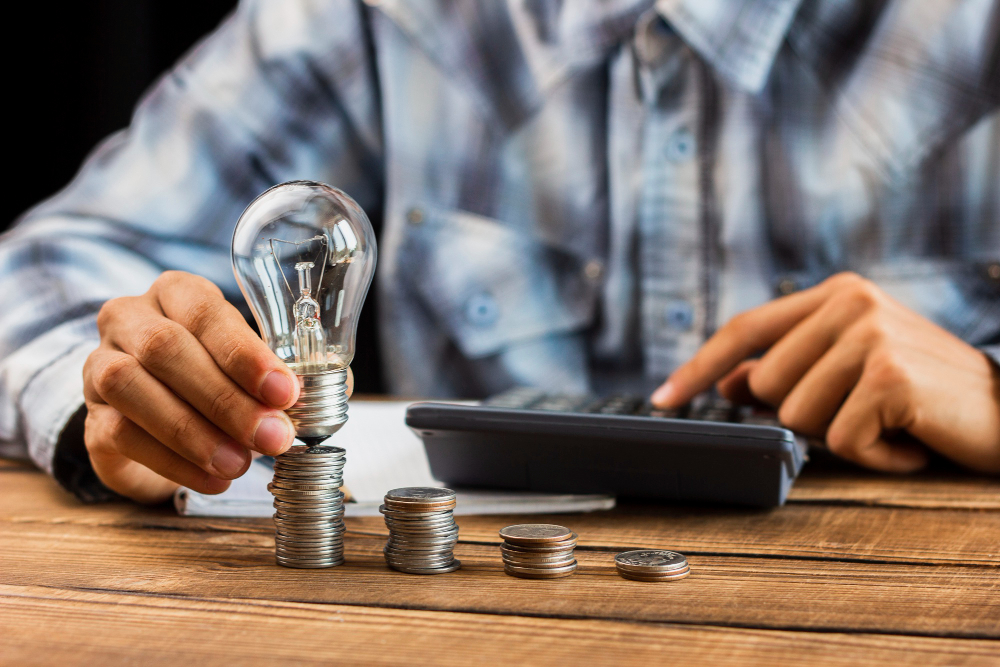Looking to cut down on energy use and lower bills? Start by switching to energy-efficient appliances. The US uses nearly a million dollars in energy every minute, says the Department of Energy (DOE). Choosing high-efficiency appliances can save you money and help the planet. These appliances use less energy and water than regular ones.
Switching to energy-efficient appliances lets you join millions saving $12 billion on bills. These appliances cut down energy use and lower bills. Plus, they help the environment.
Key Takeaways
- Energy-efficient appliances can save you money on your utility bills
- Energy-saving home appliances can help reduce your environmental footprint
- Upgrading to energy-efficient appliances can help you join the millions of Americans who have already saved $12 billion on utility bills
- Energy-efficient appliances use less energy and water than standard models
- By choosing energy-efficient appliances, you can do your part to reduce greenhouse gas emissions and protect the environment
- Energy-efficient appliances can save the average household $450 a year
- Energy-efficient appliances are a smart choice for your home and the planet
Understanding Energy-Efficient Appliances and Their Impact
Choosing energy-efficient appliances can cut down your energy use and lower bills. These devices use the latest tech to work better while using less power.
What Makes an Appliance Energy Efficient?
Energy-efficient appliances have special features like better insulation and smart sensors. These eco-friendly kitchen gadgets aim to reduce energy waste and boost efficiency.
The ENERGY STAR Rating System
The ENERGY STAR rating system was started in 1992 by the EPA. It helps find products that meet high energy standards. Appliances with the ENERGY STAR logo use 20% less energy than usual, saving money and the planet.
Long-term Benefits for Households
Buying energy-efficient appliances brings many advantages, including:
- Big savings on energy bills over time
- Less greenhouse gas emissions
- Better performance and longer life for appliances
| Benefit | Impact |
|---|---|
| Cost Savings | Up to $575 annually on energy bills |
| Environmental Impact | Reduced greenhouse gas emissions by over 300 million metric tons |
| Energy Consumption | At least 20% less energy usage |
The Financial Benefits of Energy-Efficient Home Solutions
Buying energy-efficient appliances can cut down your household costs. These appliances might cost more upfront. But, they save you money on utility bills in the long run.
The U.S. Department of Energy says the average American wastes about $400 a year on energy waste. Switching to energy-efficient models can reduce this by up to 50 percent.

Energy-efficient appliances can save you thousands over time. For instance, an Energy Star-certified water heater can save up to $3,500 compared to regular models. Energy Star clothes washers can save about $550 in energy costs over their life.
- Using less energy and water means lower monthly bills.
- Rebates and tax credits, like the IRS tax credit for heat pumps, can help with the cost.
- These savings often cover the initial cost in a few years.
Also, energy-efficient appliance reviews help you pick the right ones for your budget and lifestyle. These reviews give you the lowdown on performance, savings, and incentives. They help you make smart choices.
With up to $8.8 billion for energy efficiency rebates from the Inflation Reduction Act, now is a great time to get energy-efficient home solutions. These investments save you money and help the planet.
Popular Types of Energy-Efficient Appliances for Your Home
Switching to energy-efficient appliances can greatly cut down your home’s energy use and bills. Here are some top picks:
Refrigerators and Freezers
Energy-saving refrigerators are a top pick for lowering energy use at home. They have better insulation, LED lights, and smart temperature controls. This means they work well while using less energy.
By adjusting the fridge’s temperature and using energy-saving tips, you can cut down its energy use a lot.
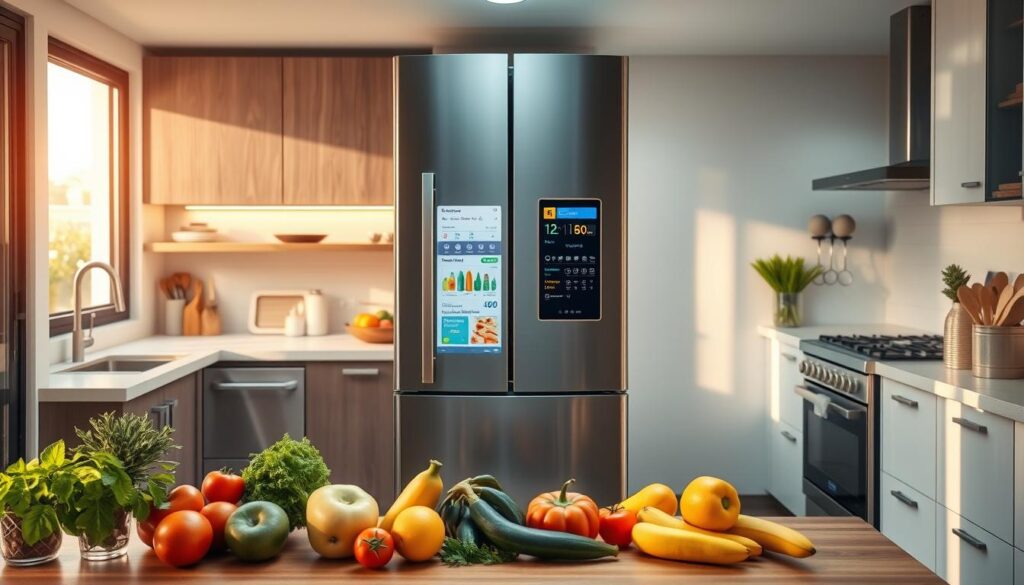
Washing Machines and Dryers
Modern washing machines and dryers use new tech to use less water and energy. They have features like load sensing and eco-friendly cycles. These can save up to 40% on energy and 25% on water compared to old models.
Using air to dry clothes can also help reduce energy use.
Dishwashers
Energy-Star-qualified dishwashers use 25% less energy than the minimum standard. Over time, they can save you about $100 and 3,870 gallons of water. They often have soil sensors that adjust water based on how dirty the dishes are.
- 25% less energy consumption
- Save $100 annually on utility bills
- Conserve 3,870 gallons of water over lifetime
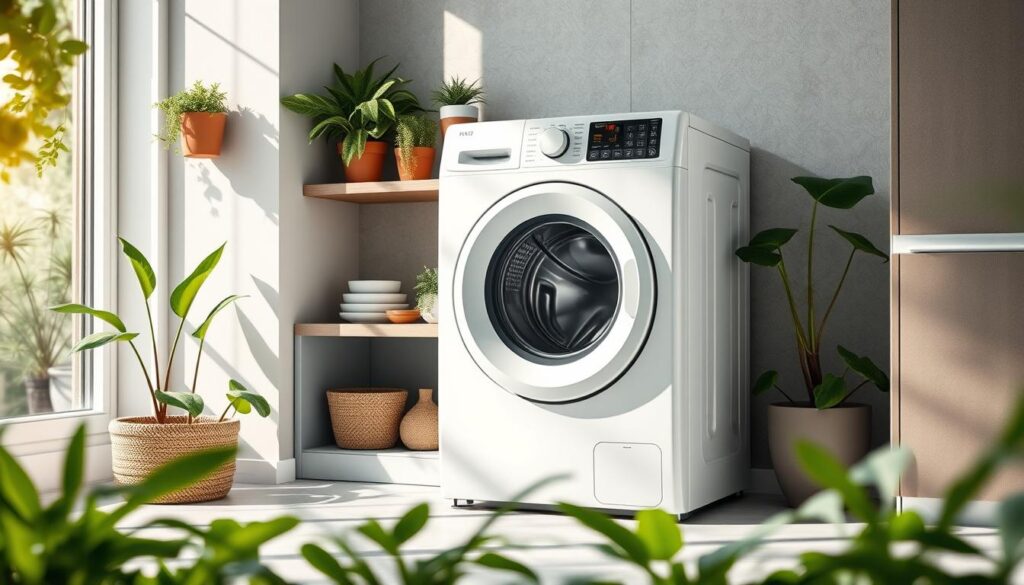
HVAC Systems
Getting a new energy-efficient HVAC system can save a lot of energy. These systems have smart thermostats, variable-speed motors, and high-efficiency heat pumps. They can cut electricity use by up to 50% compared to old furnaces.
Buying a modern HVAC system not only saves money on bills but also makes your home more comfortable.
Smart Features in Modern Energy-Efficient Appliances
Energy-efficient smart appliances make your home more convenient and save you money. They connect to Wi-Fi and use apps on your smartphone. This lets you control them from anywhere.
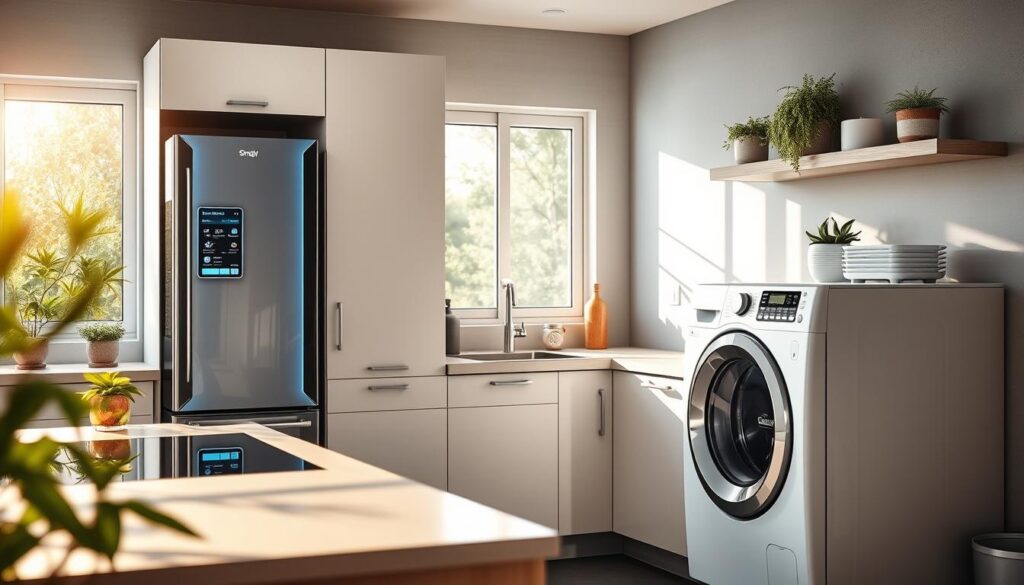
Smart thermostats learn your routine and adjust the temperature to save energy. Refrigerators have energy-saving modes to use less power. Washing machines use only what they need for each cycle, thanks to load-sensing technology.
- Adaptive Learning Thermostats: Automatically adjust based on your habits.
- Smart Refrigerators: Feature energy-saving modes and advanced insulation.
- Load-Sensing Washing Machines: Optimize resources per load.
These smart appliances often have automated energy management systems. They help you keep an eye on and control your energy use. By working with home energy management systems, you can use less electricity during peak hours. This cuts down your bills and makes your home more efficient.
| Smart Feature | Benefit |
|---|---|
| Wi-Fi Connectivity | Remote control and monitoring of appliances |
| Smart Thermostats | Automated temperature adjustments based on your schedule |
| Load-Sensing Technology | Optimizes water and energy use for each laundry cycle |
| Energy-Saving Modes | Reduces power consumption without compromising performance |
How to Choose the Right Energy-Efficient Appliances
Choosing the right energy-efficient appliances starts with understanding their labels. These labels tell you how much energy an appliance uses and how efficient it is.
Evaluating Energy Usage Labels
The ENERGY STAR rating is a key indicator of efficiency. Appliances with this label use less energy than the minimum federal standards. They can save you a lot of money on energy costs over time. The EnergyGuide label also shows estimated yearly operating costs. This helps you compare different models.
Size and Capacity Considerations
Choosing the right size is key to avoid wasting energy. Big appliances use more energy and resources than needed. Make sure to pick appliances that fit your household needs. This ensures you get the best efficiency and save money.
Cost vs. Performance Analysis
Energy-efficient appliances might cost more upfront. But they can save you money in the long run. Compare the initial cost to the energy savings and better performance over time.

| Appliance | Average Lifespan | Energy Savings |
|---|---|---|
| Refrigerators | 12 years | 300-500 kWh/year |
| Clothes Washers | 11 years | 25% less energy |
| Room Air Conditioners | 9 years | Up to 15% more efficient |
| Dishwashers | 10 years | 25% less energy and 3,870 gallons water saved |
Environmental Impact and Sustainability Benefits
Using eco-friendly kitchen gadgets makes cooking better and helps our planet. They save energy, making our environment healthier. This choice supports sustainability in our daily lives.
Carbon Footprint Reduction
Energy-saving kitchen tools cut down your home’s carbon footprint. In 2016, U.S. homes were responsible for almost 19% of greenhouse gas emissions. By picking appliances that use less energy, you cut down on harmful emissions.
For example, switching to CFL bulbs can save 75% of electricity. This is like taking 800,000 cars off the road every year.
Resource Conservation
These gadgets save water and raw materials. ENERGY STAR certified washers use up to 30% less water. Refrigerators with new tech use 9% less energy.
This saves the environment and cuts down on utility bills.
Recycling Old Appliances
Recycling old appliances is key to lessening environmental harm. Don’t just donate them; recycle them to avoid wasting energy. Many stores that sell and install new appliances offer recycling services.
The EPA also has resources for safe disposal. Or, use Earth911 to find a recycling site near you by entering your zip code.

| Benefit | Description |
|---|---|
| Carbon Emission Reduction | Lower energy usage leads to fewer greenhouse gases released. |
| Water Conservation | Appliances like energy-efficient dishwashers use significantly less water. |
| Resource Savings | Reduces the need for raw materials in manufacturing new appliances. |
| Cost Savings | Lower utility bills due to reduced energy and water consumption. |
| Recycling Benefits | Proper disposal of old appliances maximizes resource recovery and minimizes waste. |
Available Rebates and Tax Incentives
Buying energy-saving home appliances can be cheaper thanks to rebates and tax incentives. These benefits lower the upfront cost. This makes it simpler to get efficient technology.

The Home Energy Rebates initiative aims to cut energy bills by up to $1 billion a year. Homeowners can get up to $3,200 in federal income tax credits for energy-efficient upgrades. Some states also offer special rebates.
- Wisconsin: Launched the Home Electrification and Appliance Rebates Program on December 19, 2024.
- New York: Introduced In-Store Home Energy Rebates for Appliances on November 21, 2024.
Utility companies also offer rebates for efficient models. Contact your local provider to find out more and save money.
To get these incentives, you need to:
- Look into local and federal programs.
- Make sure your appliance qualifies.
- Fill out forms like IRS Form 5695 for federal tax credits.
Spreading out your energy upgrades over years can help you use all the credit limits. For more info and help, check the Energy Star website.
Installation and Maintenance Tips for Maximum Efficiency
Getting your energy-efficient devices installed right and keeping them up is key. It makes them work better and last longer.

Professional Installation Benefits
Getting pros to install complex systems like HVAC units is a smart move. They pick the right size for your home, avoiding energy waste. They also make sure everything is connected properly, avoiding leaks and inefficiencies.
Regular Maintenance Schedule
Having a regular maintenance plan is important. For example, cleaning your fridge’s condenser coils every six months boosts cooling. Also, check and replace HVAC filters often to keep air flowing well.
Troubleshooting Common Issues
Fixing small problems early can save you from big repairs later. Issues like clogged dishwasher filters or bad fridge seals can cut down on efficiency. Knowing how to spot and fix these problems can keep your devices running smoothly.
| Appliance | Maintenance Task | Frequency |
|---|---|---|
| Refrigerator | Clean condenser coils | Every 6 months |
| Dishwasher | Use energy-saving mode | Each use |
| Washing Machine | Use cold water and high-efficiency detergent | Each load |
| Dryer | Leave space for clothes to tumble | Each use |
| HVAC Systems | Annual tune-up | Yearly |
| Maximize Savings with Edison’s “Lost Invention” Energy-efficient appliances are a great step, but what if you could go even further? Edison’s “Lost Invention” offers the ability to generate unlimited energy on demand, helping you save even more while reducing your environmental impact. Take the next step toward ultimate efficiency today. Click here to learn more! |
Conclusion: Making the Switch to Energy Efficiency
Switching to energy efficient appliances is a big step towards using less energy at home. These appliances don’t just save you money on bills. They also help protect our planet.
Choosing energy-efficient appliances means you’re doing your part for the environment. You’ll use less energy and save money on bills. This makes upgrading a smart choice for your home.
To start, do an energy audit of your home. This will show you where you can use less energy. Look for energy-efficient appliances that fit your needs and budget. Also, check out local programs that offer rebates to help with the cost.
Energy efficiency is more than a trend; it’s essential for a sustainable future. As technology gets better, energy-efficient appliances will keep helping us live greener. Make the change today for a brighter tomorrow.
FAQ
What are energy-efficient appliances and how do they work?
Energy-efficient appliances use less energy than old models. They have new tech like better insulation and smart sensors. This means they save you money and help the planet.
How does the ENERGY STAR rating system help in choosing energy-saving home appliances?
The ENERGY STAR label shows if an appliance is energy-smart. It’s set by the U.S. EPA. Choosing these appliances saves you money and helps the environment.
What financial benefits can I expect from upgrading to energy-efficient refrigerators and washing machines?
New energy-efficient appliances cut down on your bills. They use less power and water. Plus, you might get rebates or tax credits, making them worth it in the long run.
What are some popular eco-friendly kitchen gadgets that can help save energy?
Look for energy-saving dishwashers, induction cooktops, and smart fridges. They use new tech to use less energy. For example, induction cooktops heat fast and use less power than old stoves.
How do smart features in energy-efficient smart appliances enhance energy savings?
Smart appliances let you control them from your phone. They learn your habits to use less energy. This saves you money and makes your home more efficient.
What should I consider when selecting the right size and capacity for energy-efficient appliances?
Pick appliances that fit your needs but aren’t too big. Big appliances waste energy and cost more. Check the labels and ENERGY STAR ratings to find the right balance.
Are there any government incentives available for purchasing energy-efficient home appliances?
Yes, there are rebates and tax credits for energy-saving appliances. Check what’s available in your area. Follow the steps to get your savings.
How can proper installation and maintenance maximize the efficiency of energy-efficient appliances?
Right installation and upkeep are key. Get pros to install complex systems. Regular checks and quick fixes keep them running well.
What environmental benefits come from using energy-efficient appliances in my home?
Energy-efficient appliances cut down on energy use. This means less pollution and helps fight climate change. They also save water and resources, and recycling them is good for the planet.
How do energy-efficient cooking appliances compare to traditional models in terms of energy usage?
New cooking appliances like induction cooktops and convection ovens use less energy. They cook faster and more evenly, saving energy and improving your cooking.
What should I look for in energy-efficient appliance reviews when choosing new devices?
Look for reviews that talk about energy use, performance, and reliability. Choose appliances that get good marks from users. This helps you find the best ones for saving energy.
Source Links
- Energy Efficiency
- Buying Energy-Efficient Appliances
- Energy Efficiency: The Clean Facts
- Fact Sheet | Energy Efficiency Standards for Appliances, Lighting and Equipment (2017) | White Papers
- What are the Benefits of Energy-Efficient Appliances? | Vista Energy Marketing
- Energy Efficiency Costs & Benefits Explained
- How Much Can You Save With Energy Efficient Appliances?
- Energy-Efficient Appliances
- 8 Best Appliances for Your Energy-Efficient Home – Ross and Witmer
- Best Energy Efficient Home Upgrades | Arizona Central Credit Union
- Shopping for Appliances and Electronics
- Overview of Energy-Efficient Technologies | Energy | U.S. Agency for International Development
- The Benefits of Energy-Efficient Appliances
- How to choose energy-efficient appliances – a 9-step guide
- How Does Energy Efficiency Help the Environment?
- Do Energy-Efficient Appliances Really Make a Difference?
- Home Energy Rebates Programs
- Federal Tax Credits for Energy Efficiency
- Energy Efficient Home Improvement Credit
- 7 Essential Tips to Maintain Home Appliances – NashFix
- Maintaining Energy Efficient Appliances: Tips and Tricks – Gulf Coast Appliance Repair
- Conclusions | Energy Efficiency Impact Report
- Why Energy-Efficiency is Crucial for a Sustainable Future – Island Gardens
- The Importance of Energy Efficiency in Combating Climate Change – Collective Clean Energy Fund
Affiliate Disclosure: This article contains affiliate links, meaning I may earn a commission if you click through and make a purchase, at no extra cost to you.


